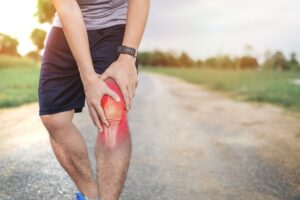Inflammatory mediators of osteoarthritis of knee joint
Osteoarthritis (OA) of the knee joint involves a complex interplay of inflammatory and degenerative processes. While traditionally considered primarily a degenerative condition, research has increasingly highlighted the significant role of inflammation in its pathogenesis. Several inflammatory mediators contribute to the progression of OA in the knee joint. Some of the key ones include:
- Cytokines: Various pro-inflammatory cytokines play pivotal roles in the inflammatory cascade of OA. These include interleukin-1 (IL-1), interleukin-6 (IL-6), interleukin-8 (IL-8), tumor necrosis factor-alpha (TNF-α), and interleukin-17 (IL-17). These cytokines are produced by chondrocytes, synovial cells, and infiltrating immune cells, leading to cartilage degradation, synovial inflammation, and pain.

- Chemokines: Chemokines are a group of small cytokines involved in immune cell recruitment and activation. In OA, chemokines such as monocyte chemoattractant protein-1 (MCP-1) and macrophage inflammatory protein-1 alpha (MIP-1α) promote the infiltration of macrophages and other immune cells into the synovium and articular cartilage, exacerbating inflammation and tissue damage.
- Matrix Metalloproteinases (MMPs): MMPs are enzymes responsible for degrading extracellular matrix components, including collagen and proteoglycans. In OA, elevated levels of MMPs, particularly MMP-1, MMP-3, and MMP-13, contribute to cartilage degradation and subchondral bone remodeling, leading to joint damage and dysfunction.
- Prostaglandins: Prostaglandins, particularly prostaglandin E2 (PGE2), are lipid mediators produced by the enzymatic action of cyclooxygenase (COX) enzymes. PGE2 promotes inflammation, pain, and cartilage breakdown in OA by stimulating the production of cytokines, MMPs, and other inflammatory mediators.
- Nitric Oxide (NO): NO is a reactive nitrogen species produced by various cells in the joint, including chondrocytes and synoviocytes. Elevated levels of NO in OA contribute to cartilage degradation by inhibiting matrix synthesis, promoting MMP activity, and inducing chondrocyte apoptosis.
- Advanced Glycation End Products (AGEs): AGEs are molecules formed by the non-enzymatic glycation of proteins and lipids. In OA, AGEs accumulate in joint tissues and contribute to inflammation and cartilage degradation by activating receptor-mediated signaling pathways and promoting oxidative stress.
- Adipokines: Adipokines are cytokines produced by adipose tissue. Leptin and adiponectin, two adipokines implicated in OA, modulate inflammation, matrix degradation, and cartilage metabolism in the knee joint, potentially contributing to disease progression.
Understanding the roles of these inflammatory mediators in the pathogenesis of OA provides insights into potential therapeutic targets for disease modification and symptom management. Targeting inflammation represents a promising approach to slowing down the progression of OA and alleviating symptoms, thereby improving the quality of life for affected individuals.
How does embolization of genicular arteries reduce inflammation in knee joints?
Embolization of genicular arteries is a minimally invasive procedure that involves the selective occlusion of specific arteries supplying blood to the knee joint. While embolization is typically used to treat conditions such as chronic knee pain or osteoarthritis (OA), its mechanism of action in reducing inflammation in the knee joint is not fully understood and may involve several potential mechanisms:
- Reduction of Synovial Blood Flow: By blocking or reducing blood flow to the synovium (the lining of the joint capsule), embolization may decrease the delivery of inflammatory mediators, immune cells, and nutrients to the synovial tissue. This reduction in blood flow can help dampen the inflammatory response within the joint.
- Decreased Inflammatory Mediator Release: Embolization may disrupt the microvasculature and alter the local environment within the knee joint, leading to decreased release of pro-inflammatory cytokines, chemokines, and other inflammatory mediators from synovial cells, chondrocytes, and infiltrating immune cells.
- Modulation of Nociceptive Pathways: Chronic knee pain associated with inflammation in conditions like OA can be mediated by sensory nerve fibers within the joint capsule. By reducing inflammation and altering the local environment, embolization may modulate nociceptive (pain) pathways, leading to a reduction in pain perception.
- Induction of Ischemic Hypoxia: The occlusion of genicular arteries through embolization induces ischemia (reduced blood flow) and hypoxia (reduced oxygen levels) in the targeted areas of the knee joint. While ischemia can initially exacerbate inflammation, it may also trigger adaptive responses that ultimately lead to the resolution of inflammation and tissue repair.
- Inhibition of Angiogenesis: In conditions like OA, abnormal angiogenesis (formation of new blood vessels) within the synovium can contribute to inflammation and disease progression. Embolization may disrupt angiogenic processes by blocking the supply of oxygen and nutrients necessary for neovascularization, thereby inhibiting the perpetuation of inflammation.
It’s essential to note that while embolization of genicular arteries shows promise in reducing inflammation and alleviating symptoms in certain individuals with knee joint conditions, including OA, its efficacy and safety may vary among patients. Embolization is typically considered after conservative treatments have failed, and it’s performed under the guidance of interventional radiologists or vascular specialists.
Visit us today to learn more about genicular artery embolization and whether it may be a suitable option for you. Our team of experts can provide personalized treatment plans tailored to your specific needs, helping you find relief from knee joint pain and improve your overall quality of life. Don’t let inflammation hold you back any longer – take the first step towards a pain-free future with Premier Vein.
